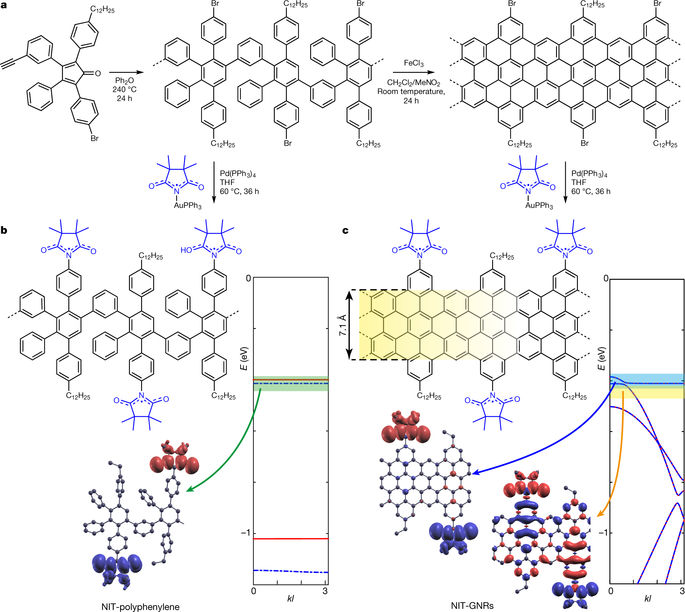Our official English website, www.x-mol.net, welcomes your
feedback! (Note: you will need to create a separate account there.)
Magnetic edge states and coherent manipulation of graphene nanoribbons
Nature ( IF 50.5 ) Pub Date : 2018-05-01 , DOI: 10.1038/s41586-018-0154-7 Michael Slota , Ashok Keerthi , William K. Myers , Evgeny Tretyakov , Martin Baumgarten , Arzhang Ardavan , Hatef Sadeghi , Colin J. Lambert , Akimitsu Narita , Klaus Müllen , Lapo Bogani
Nature ( IF 50.5 ) Pub Date : 2018-05-01 , DOI: 10.1038/s41586-018-0154-7 Michael Slota , Ashok Keerthi , William K. Myers , Evgeny Tretyakov , Martin Baumgarten , Arzhang Ardavan , Hatef Sadeghi , Colin J. Lambert , Akimitsu Narita , Klaus Müllen , Lapo Bogani

|
Graphene, a single-layer network of carbon atoms, has outstanding electrical and mechanical properties1. Graphene ribbons with nanometre-scale widths2,3 (nanoribbons) should exhibit half-metallicity4 and quantum confinement. Magnetic edges in graphene nanoribbons5,6 have been studied extensively from a theoretical standpoint because their coherent manipulation would be a milestone for spintronic7 and quantum computing devices8. However, experimental investigations have been hampered because nanoribbon edges cannot be produced with atomic precision and the graphene terminations that have been proposed are chemically unstable9. Here we address both of these problems, by using molecular graphene nanoribbons functionalized with stable spin-bearing radical groups. We observe the predicted delocalized magnetic edge states and test theoretical models of the spin dynamics and spin–environment interactions. Comparison with a non-graphitized reference material enables us to clearly identify the characteristic behaviour of the radical-functionalized graphene nanoribbons. We quantify the parameters of spin–orbit coupling, define the interaction patterns and determine the spin decoherence channels. Even without any optimization, the spin coherence time is in the range of microseconds at room temperature, and we perform quantum inversion operations between edge and radical spins. Our approach provides a way of testing the theory of magnetism in graphene nanoribbons experimentally. The coherence times that we observe open up encouraging prospects for the use of magnetic nanoribbons in quantum spintronic devices.By functionalizing molecular graphene nanoribbons with stable spin-bearing nitronyl nitroxide radical groups, delocalized magnetic edge states are observed, with microsecond-scale spin coherence times.
中文翻译:

石墨烯纳米带的磁性边缘状态和相干操作
石墨烯是一种单层碳原子网络,具有出色的电气和机械性能1。具有纳米级宽度 2,3(纳米带)的石墨烯带应表现出半金属性 4 和量子限制。石墨烯纳米带 5,6 中的磁性边缘已从理论角度进行了广泛研究,因为它们的相干操作将成为自旋电子 7 和量子计算设备 8 的里程碑。然而,实验研究受到阻碍,因为纳米带边缘不能以原子精度产生,并且已经提出的石墨烯末端在化学上不稳定 9。在这里,我们通过使用带有稳定自旋自由基基团功能化的分子石墨烯纳米带来解决这两个问题。我们观察了预测的离域磁边缘状态并测试了自旋动力学和自旋-环境相互作用的理论模型。与非石墨化参考材料的比较使我们能够清楚地识别自由基功能化石墨烯纳米带的特征行为。我们量化了自旋轨道耦合的参数,定义了相互作用模式并确定了自旋退相干通道。即使没有任何优化,自旋相干时间在室温下也在微秒范围内,我们在边缘和自由基自旋之间执行量子反演操作。我们的方法提供了一种通过实验测试石墨烯纳米带磁性理论的方法。我们观察到的相干时间为在量子自旋电子器件中使用磁性纳米带开辟了令人鼓舞的前景。
更新日期:2018-05-01
中文翻译:

石墨烯纳米带的磁性边缘状态和相干操作
石墨烯是一种单层碳原子网络,具有出色的电气和机械性能1。具有纳米级宽度 2,3(纳米带)的石墨烯带应表现出半金属性 4 和量子限制。石墨烯纳米带 5,6 中的磁性边缘已从理论角度进行了广泛研究,因为它们的相干操作将成为自旋电子 7 和量子计算设备 8 的里程碑。然而,实验研究受到阻碍,因为纳米带边缘不能以原子精度产生,并且已经提出的石墨烯末端在化学上不稳定 9。在这里,我们通过使用带有稳定自旋自由基基团功能化的分子石墨烯纳米带来解决这两个问题。我们观察了预测的离域磁边缘状态并测试了自旋动力学和自旋-环境相互作用的理论模型。与非石墨化参考材料的比较使我们能够清楚地识别自由基功能化石墨烯纳米带的特征行为。我们量化了自旋轨道耦合的参数,定义了相互作用模式并确定了自旋退相干通道。即使没有任何优化,自旋相干时间在室温下也在微秒范围内,我们在边缘和自由基自旋之间执行量子反演操作。我们的方法提供了一种通过实验测试石墨烯纳米带磁性理论的方法。我们观察到的相干时间为在量子自旋电子器件中使用磁性纳米带开辟了令人鼓舞的前景。











































 京公网安备 11010802027423号
京公网安备 11010802027423号